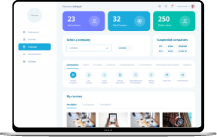AI Governance: Opportunities and Challenges in Cybersecurity
With the increasing reliance on AI technologies in various fields, AI Governance has become a key factor to ensure system integrity and data protection.
This governance plays an essential role in enhancing confidence in modern technology and ensuring that it is used responsibly.
It has been almost two years since OpenAI’s ChatGPT went viral, igniting widespread interest in artificial intelligence (AI) and setting off a wave of technological and investment growth in the field.
Academic and technical investments in artificial intelligence:
The advancements in AI since then have been staggering, with exponential increases in both research and funding. For instance, NeurIPS 2023 received a record 5,875 paper submissions, with around 26% acceptance, while ICML 2023 reviewed nearly 6,000 submissions and accepted about 21%.
In addition to academic growth, investment in generative AI alone has multiplied, reaching $25.2 billion, nearly eight times what it was in 2022, with a significant portion directed toward data centers, electricity, and GPUs. Yet, the question of how to effectively monetize these investments remains open.
Artificial intelligence’s involvement in combating cyberthreats
In the cybersecurity landscape, AI has become a powerful enabler, bringing significant advancements across several use cases. Anomaly detection, for example, is one area where machine learning and deep learning techniques have proven highly effective, enhancing capabilities for detecting unusual patterns that could signal cyber threats. Large Language Models (LLMs), including those similar to ChatGPT, are also increasingly leveraged in crafting phishing simulation scenarios Phishing.
In fraud detection, AI provides tools to uncover and prevent fraudulent activities, while intelligent authentication methods mPass improve identity verification and reduce unauthorized access risks.
Moreover, automation in Security Operation Centers (SOC) relies on AI to streamline responses and incident management, making security teams more efficient and proactive.
Challenges and risks associated with AI developments
However, as AI progresses, it also introduces new cybersecurity risks that must be addressed early and managed carefully. The critical need for cybersecurity considerations is essential from the design phase onward, as demonstrated by recent incidents:
Hugging Face says it detected ‘unauthorized access’ to its AI model hosting platform as more vulnerabilities and bugs are found where in some cases, hosted code that backdoored user devices.
Other vulnerabilities were found in LLMs related systems such as LangChain
Other areas such the use of deepfake to distribute misinformation
Areas such as infrastructure security can be a target as well
Defense applications of artificial intelligence developments in cybersecurity:
On the positive side, AI and LLMs also have defensive cybersecurity applications, such as identifying zero-day vulnerabilities in code and providing remediation guidance. This “AI for security” approach complements traditional methods and aids in uncovering threats quickly.
AI Governance
Over recent years, AI has revolutionized various sectors thanks to its ability to handle data efficiently and quickly.
With the development of these technologies, the importance of artificial intelligence governance has emerged, as it has become necessary to implement policies and procedures that ensure their safe and ethical use that maintain information security and the safety of society.
To foster responsible AI use, companies must adopt a robust
AI Governance and security framework that addresses the following:
AI Privacy and Data Protection
Data privacy protection occupies a key position within AI Governance policies.
As more Data is used to fine-tune AI models, organizations must adhere to privacy regulations such as GDPR or local frameworks like NDMO, ensuring that data handling complies with privacy standards. This includes minimizing data collection, anonymizing data, ensuring user consent, and enabling data portability.
AI Infrastructure Security
AI models and the infrastructure they rely on are increasingly attractive targets for cyberattacks.
It’s critical to integrate security checkpoints early in the development process rather than retrofitting them later.
Companies should adopt “security by design” principles to protect AI systems from attacks and data leaks.
Ethics and Guardrails Against Harmful Use
It is essential to build ethical guardrails to prevent AI from facilitating harmful outcomes, such as generating deepfakes, spreading misinformation, or supporting other malicious activities. This can include establishing guidelines on responsible use, regularly monitoring outputs for harmful content, and implementing bias-checking algorithms to prevent unintended consequences.
Fairness and Bias Mitigation
Ensuring that AI systems do not propagate or amplify biases related to race, gender, or other sensitive attributes is essential for ethical AI governance. Companies should adopt techniques for bias detection and mitigation during model training and testing. Diverse datasets and continuous monitoring for disparate impact help create fairer AI outcomes.
Sustainability Considerations
The energy consumption associated with training and deploying large AI models has significant environmental impacts. Companies should adopt sustainability practices by optimizing models for energy efficiency, considering green data centers, and reporting on the environmental footprint of AI projects.
Conclusion
As AI reshapes both opportunities and risks in IT, adopting a proactive stance on AI governance will be essential to maximize benefits while minimizing potential harms.
In the midst of the rapid development of AI technologies, AI security is emerging as a critical factor to ensure that digital systems are protected and data is kept safe.
Cyber challenges continue to grow, necessitating the development of advanced and continuous strategies to enhance security.
With each new opportunity offered by AI comes an even greater commitment to implementing strong practices that ensure a safe and sustainable digital future.
Share this article:
Popular

Revolutionize Enterprise Communication Platform with LinQ2
Revolutionize Enterprise Communication Platform with LinQ2 In today’s fast-paced business environment, enterprise communication platform is the backbone of success. Whether reaching customers, coordinating with employees, or automating notifications, having an effective enterprise communication platform is essential. Cerebra’s LinQ2 stands out as the ultimate solution, offering a multi-channel notification platform tailored for businesses of all sizes. Why Enterprise Communication Platform Is Essential for Business Growth? Efficient enterprise communication platform ensures businesses can stay connected with their customers and teams in real time. Poor communication systems often lead to missed opportunities, customer dissatisfaction, and delays in internal operations. Key Features of LinQ2 ...
11th Mar 2025
Deepfake in Phishing: Challenges and Solutions
In the era of advanced technologies, especially with the explosive adoption of Large Language Models (LLMs) and Generative Artificial Intelligence (GenAI), deepfake has emerged as one of the most significant challenges in cybersecurity. This technology relies on Artificial Intelligence, specifically deep learning and the use of GenAI, to create fake yet highly realistic content that is difficult to detect. Deepfake serves as a versatile tool spanning applications from entertainment to cybersecurity. However, its misuse can pose severe risks, especially in phishing schemes. What is Deepfake? Synthetic media refers to a technology that leverages deep learning algorithms to create ...
19th Dec 2024
Cyber Warfare Unveiled: Tracing the Journey from Espionage to Digital Combat
“Cyber Warfare: From Espionage to War A Journey Through Time” With the massive technological advancements, the boundaries of warfare have expanded to encompass cyberspace, where “cyber warfare” has emerged as an increasingly serious threat to individuals, institutions, and countries. The line between cyber and traditional wars has blurred for a while but recent activities in the region made it clear that cyberwars is becoming a dangerous and can lead to harming humans. In this blog, we will dive into a journey through the world of cyber warfare, seeking to understand its nature, history, impacts, types, evolution, and some solutions to ...
9th Oct 2024
Keeping Our Kids Safe Online
A Guide For Keeping Your Kids Safe Online Parents and all who are concerned about the well-being of our young kids in this digital world. Today we will discuss a topic of utmost importance: digital safety for kids. Yes, the Internet can be a very dangerous place for our young kids , especially with the spread of phishing scams. So, let us dive deeper and present to you, in this comprehensive article, a comprehensive guide on digital safety for kids. What every parent needs to pay attention to. Internet risks for kids: The internet has become a big part of ...
17th Jul 2024
Could you be hacked through Slack?
Could you be hacked through Slack? The usage of collaboration platforms such as Microsoft Teams and Slack has significantly increased, with nearly 80% of employees utilizing them. These platforms are designed to be convenient and easily manageable for daily conversations within organizations. However, what makes them easy and convenient also renders them vulnerable to cyber threats and attacks. In 2021, for instance, 780 gigabytes of data from the gaming giant Electronic Arts (EA) were breached through Slack! During the same year, a security vulnerability in Microsoft Teams was exploited to launch a widespread cyber attack on ...
12th Jun 2024
Tips To Be Cyber Protected While Traveling
Goodbye worry! A safe journey in the digital world With all the modern wonders of the digital world, we trust communication technologies on our journeys. There is no doubt that the travel experience is always more beautiful and enjoyable, but it can also pose a range of risks, especially when it comes to cybersecurity. Travelers may fall victim to phishing, Wi-Fi network spying, and theft of their personal data, which can make their journey filled with worries and tension. With the increasing prevalence of cyber threats, it is essential for travelers to follow some guidelines to protect their devices and ...
1st Apr 2024
Push Authentication: A New Era in Multi-Factor Authentication
Want To Say Goodbye To Passwords and OTP Codes? Discover Push Authentication! It is easy for your password to be compromised through phishing attacks, even if it meets the cybersecurity strong password standards and is difficult to predict So we must get to know the technique of Push based Authentication. Some may recommend that you use Multi-Factor Authentication (MFA) to increase your security. Multi-Factor Authentication (MFA): MFA is the process of logging into your account through multiple steps. It requires you to enter more information, not just your password. But there is another obstacle that arises when using such ...
14th Feb 2024
The Difference Between Phishing Attacks
The Difference Between Phishing Attacks Phishing attacks are harmful attacks used by criminals to steal personal and financial information from individuals and businesses. Attacks on individuals and businesses are becoming more common as we use the internet and technology more often in our daily lives. Phishing attacks involve the use of dishonesty and fraudulent methods to fool consumers into believing they are interacting with the trustworthiness of an unsuspecting destination, such as banks, email companies, or social media platforms. But what is the difference between phishing attacks? How can individuals and organizations protect themselves from such attacks? That is what ...
17th Jul 2023
Understanding of the Vishing Meaning
Understanding of the Vishing Meaning Vishing, a combination of “voice” and “phishing,” is a sophisticated form of cybercrime that exploits voice communication to trick individuals and extract sensitive information. In this comprehensive guide, we will explore the meaning of it, the dangers associated with it, and effective methods to protect yourself against these malicious attacks. What is Vishing meaning? Vishing refers to the fraudulent practice of using telephone services to trick individuals into revealing personal and financial information. Scammers often pose as trusted organizations or individuals to gain their victims’ trust. By using social engineering tactics and manipulating ...
5th Jul 2023











